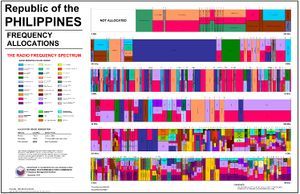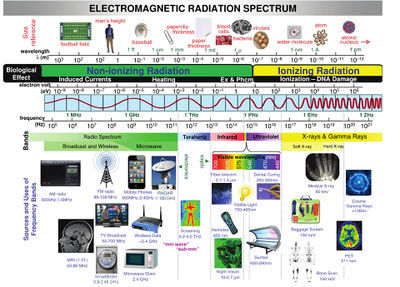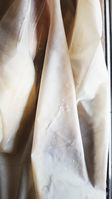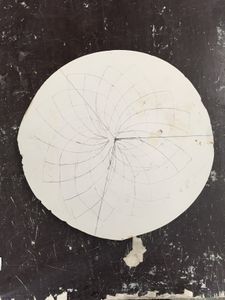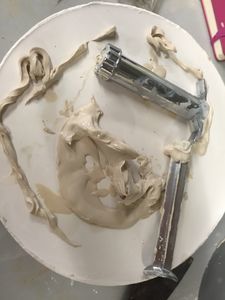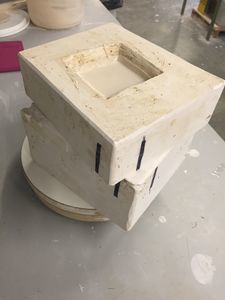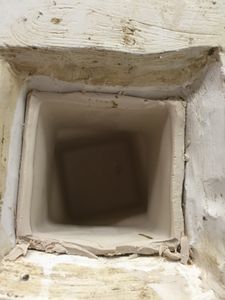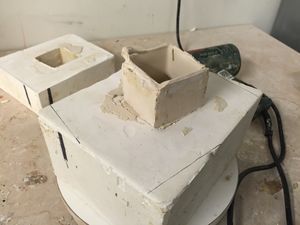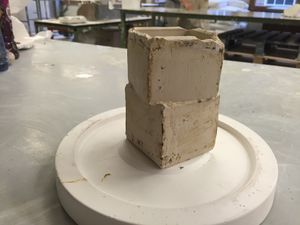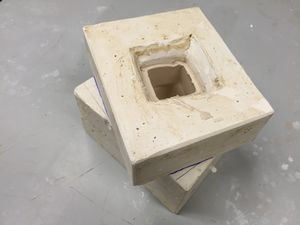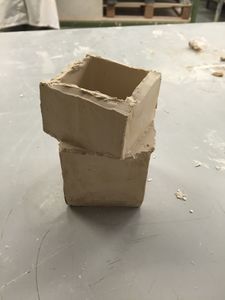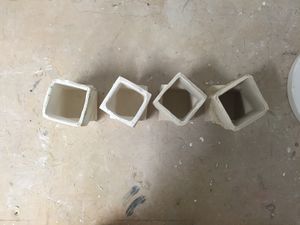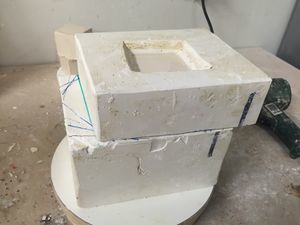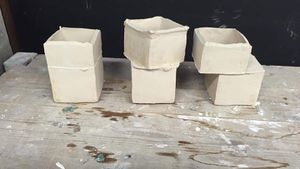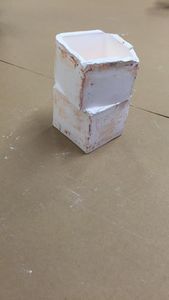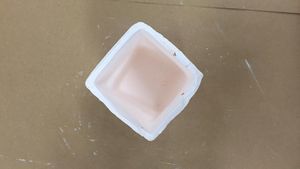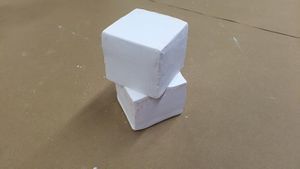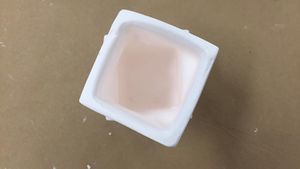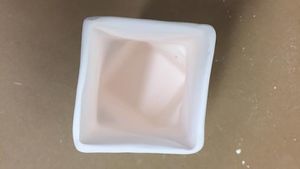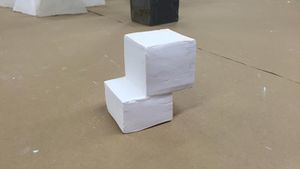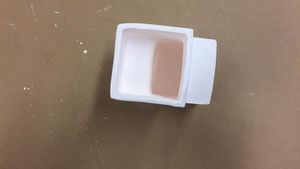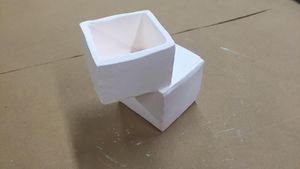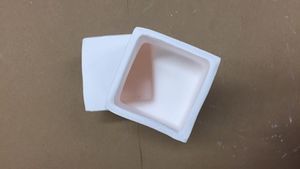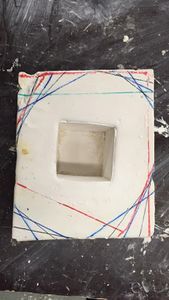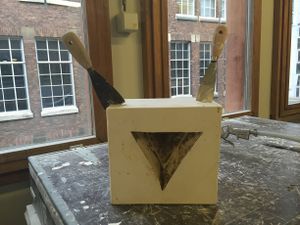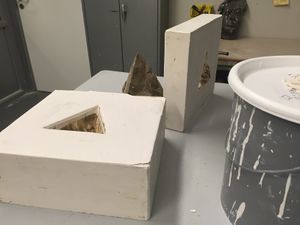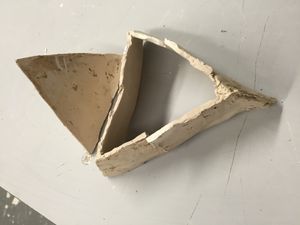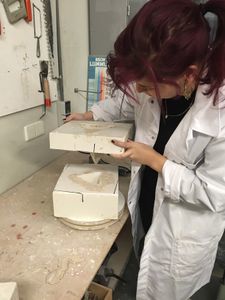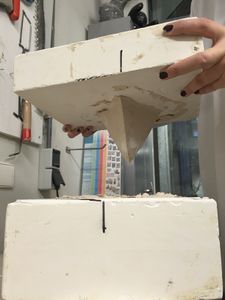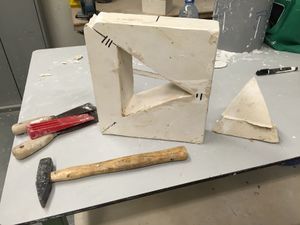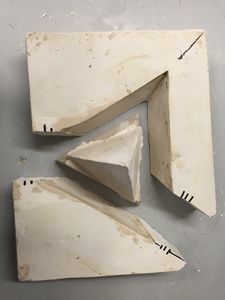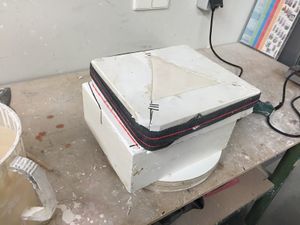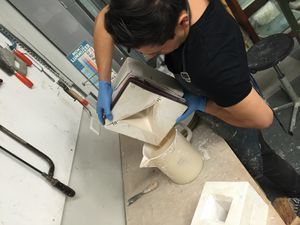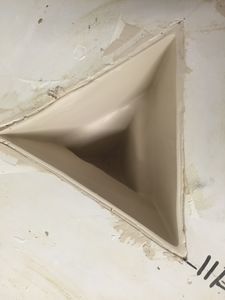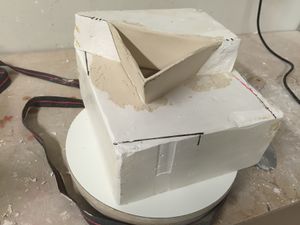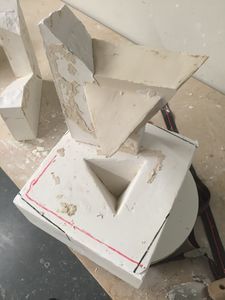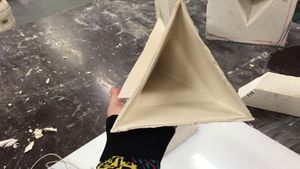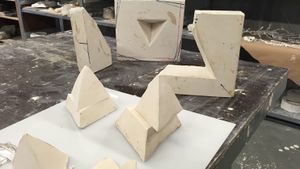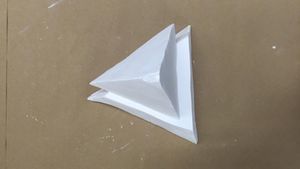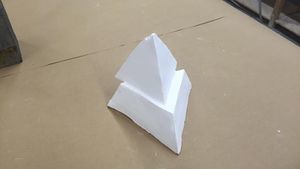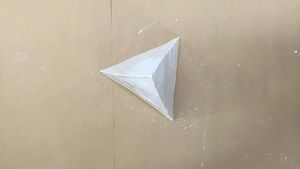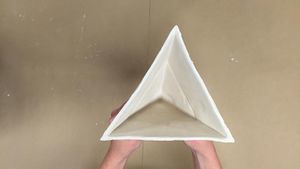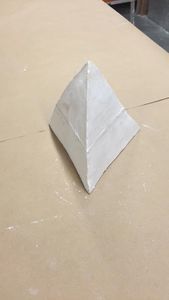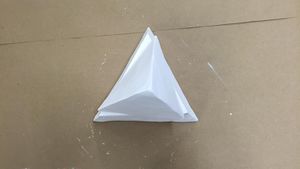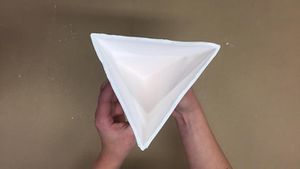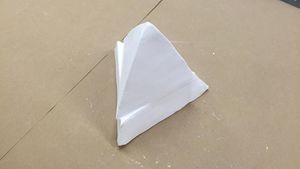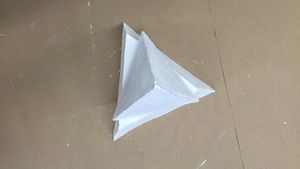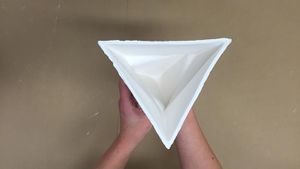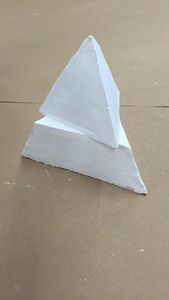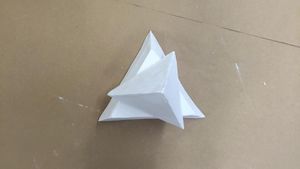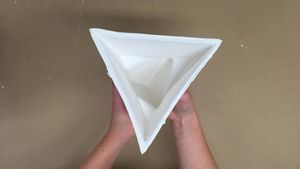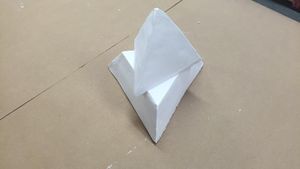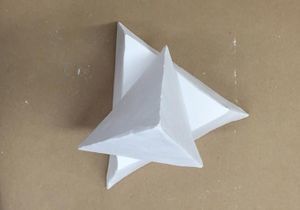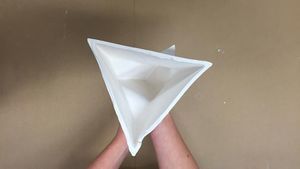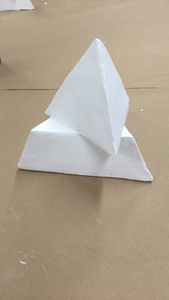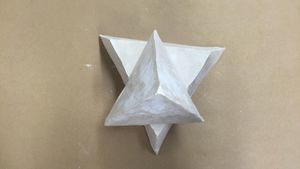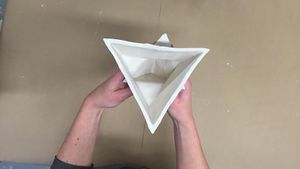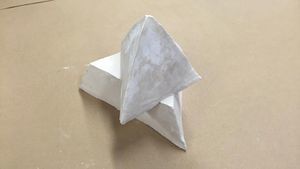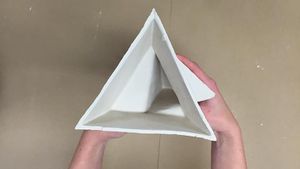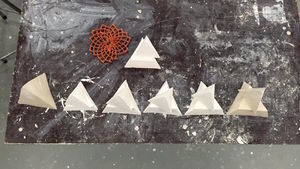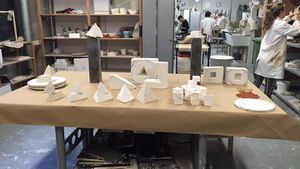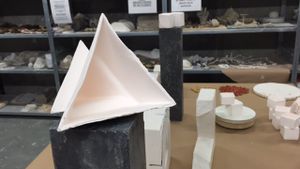Difference between revisions of "User:Pascalle/RESEARCH DOCUMENT"
| Line 36: | Line 36: | ||
Together we started researching other artistic projects concerning the theme of Radiation, with various results, as the entire EM spectrum is very large. One thing we all agreed on was that we wanted to expose the EMR processes/ waves. Whilst researching, we stumbled on a tutorial, that transformed an ordinary tape recorder into an audio device that can detect EMR from any type of device that has a current running through it which it then transforms and emit the waves into sounds - hereby making the invisible, visible. The more we experimented with the tape recorder, the more excited we got. I had never really fully realised how digital our environment actually was. But the most interesting findings were the fact that each electronic device has its own unique sound. Something I did not expect. We all tried to approach this in a different manner, varying from visualization of the sound to mapping the different sounds. But due to our limited time, we decide to combine and focus our efforts on one single perspective. For the mini exhibition, we gathered all different types of electronic devices, and asked visitors if: “they’d like to go on safari?”. We really wanted people to experiment and explore for themselves the different sounds of EMR. | Together we started researching other artistic projects concerning the theme of Radiation, with various results, as the entire EM spectrum is very large. One thing we all agreed on was that we wanted to expose the EMR processes/ waves. Whilst researching, we stumbled on a tutorial, that transformed an ordinary tape recorder into an audio device that can detect EMR from any type of device that has a current running through it which it then transforms and emit the waves into sounds - hereby making the invisible, visible. The more we experimented with the tape recorder, the more excited we got. I had never really fully realised how digital our environment actually was. But the most interesting findings were the fact that each electronic device has its own unique sound. Something I did not expect. We all tried to approach this in a different manner, varying from visualization of the sound to mapping the different sounds. But due to our limited time, we decide to combine and focus our efforts on one single perspective. For the mini exhibition, we gathered all different types of electronic devices, and asked visitors if: “they’d like to go on safari?”. We really wanted people to experiment and explore for themselves the different sounds of EMR. | ||
| + | |||
| + | <gallery mode= widths="300px" heights="300px"> | ||
| + | File:Fot5.jpg | ||
| + | File:Fot7.jpg | ||
| + | File:Fot10.jpg | ||
| + | </gallery> | ||
====Conclusion==== | ====Conclusion==== | ||
At the mini exhibition, it was exciting to see the reaction of so many viewers who went through the same amazement and surprise we went through. This invited people to form an easy dialogue with one another, which was really the main goal of our project. The project itself was completely out of my knowledge and comfort zone, but the process of discovery felt exhilarating. | At the mini exhibition, it was exciting to see the reaction of so many viewers who went through the same amazement and surprise we went through. This invited people to form an easy dialogue with one another, which was really the main goal of our project. The project itself was completely out of my knowledge and comfort zone, but the process of discovery felt exhilarating. | ||
Revision as of 12:53, 25 January 2017
Contents
- 1 Personal Statement
- 2 Experiencing the Minor
- 3 I'm 'Only' Human
- 4 Final Statement
- 5 Planning Graduation
- 6 Bibliography
Personal Statement
- Il Future ha un Cuore Antico
- The Future has an Ancient Heart_ Carlo Lev
- I am a Future Sentimentalist.
- We live in an increasingly digital environment. We are used to mirror like surfaces of smartphones, computers and tablets. This touching and swiping leaves no trace, no memory, no emotion. Yet emotional data is being used and tracked on a daily basis to pull on your heart strings and forge a psychological connection. Nonetheless feelings do not have any actual value for the third parties in the age of data. But I believe there is a deeper truth to find in genuine human emotions.
- Curious and with a keen eye I observe the modern developments in the world around me, and translate them into concepts, that convey sentiment. Stemming from my own views on societal issues, I create from a place of passion, emotion and critically asking why.
- “Several years have now elapsed since I first became aware that I had accepted, even from my youth, many false opinions for true, and that consequently what I afterward based on such principles was highly doubtful; and from that time I was convinced of the necessity of undertaking once in my life to rid myself of all the opinions I had adopted, and of commencing anew the work of building from the foundation.”
- - René Descartes, Meditation I, 1641
- The quote above is from the French philosopher René Descartes. It resonated with me because, throughout recent years I have become more critical about the information I receive(d) and process(ed). This state of mind (the Cartesian Doubt) is what I want to achieve with my practice and ultimately my audience.
- The media in which my concepts manifests is depending on the concept rather than the media. I seek to forge unexpected partnership, though I have a personal connection to ceramics. As one of the oldest technology it is still very present and relevant today. Even though humanity has used ceramics for centuries, there are still applicable innovations which I have the desire to explore, using the legacy of the old masters and their cultural heritage and adding an extra layer of new technologies.
- Because technology is build on the past, memory is build for the future, Combining the know-how of technology with the poetry of art.
- I am a Future Sentimentalist.
Experiencing the Minor
Introduction
Starting the minor I was curious and eager to work on collaborations, expand my knowledge on craft and the inner workings of technology. I wanted to learn how to inject a more critical view on technological advancements within my work. I anticipated some theory to evolve and elevate our works. Inspired and ready to be inspired, I began my Digital Craft journey. Digital craft is a minor that I felt from an early stage, suited my aspirations and work ethic, my interest and fascinations. With its critical note to society and technology and its appreciation for craftsmanship, I felt it was the right minor for me to grow. We had an intimate group of only 13 students, which overall created an easy and comfortable environment to work in, because it meant that we could really get to know our peers and the teachers. We worked within a set theme; The Radiation Spectrum. Biweekly projects, each focusing on a different asset of radiation, which meant to acquire skill, that could be applied in the final project. Radiation is all around us, electromagnetic processes that is surrounding us all almost everywhere we go, and is an essential part to many technologies that we depend on. With the exception of light, most electromagnetic processes are invisible to the human eye. This juxtaposition of exposing the everyday invisible made for very interesting projects, and gave us a lot of materials to work with.
SOUL OF THE MACHINE, ACOUSTIC RADIATION
Our first assignment kicked of our minor theme Radiation. We were grouped at random and had less than two weeks to create a mini exhibition. My group consisted of Boris, Rens (Graphic Design) and Emma (Spatial Design).
Process
Together we started researching other artistic projects concerning the theme of Radiation, with various results, as the entire EM spectrum is very large. One thing we all agreed on was that we wanted to expose the EMR processes/ waves. Whilst researching, we stumbled on a tutorial, that transformed an ordinary tape recorder into an audio device that can detect EMR from any type of device that has a current running through it which it then transforms and emit the waves into sounds - hereby making the invisible, visible. The more we experimented with the tape recorder, the more excited we got. I had never really fully realised how digital our environment actually was. But the most interesting findings were the fact that each electronic device has its own unique sound. Something I did not expect. We all tried to approach this in a different manner, varying from visualization of the sound to mapping the different sounds. But due to our limited time, we decide to combine and focus our efforts on one single perspective. For the mini exhibition, we gathered all different types of electronic devices, and asked visitors if: “they’d like to go on safari?”. We really wanted people to experiment and explore for themselves the different sounds of EMR.
Conclusion
At the mini exhibition, it was exciting to see the reaction of so many viewers who went through the same amazement and surprise we went through. This invited people to form an easy dialogue with one another, which was really the main goal of our project. The project itself was completely out of my knowledge and comfort zone, but the process of discovery felt exhilarating.
EMR BODY JEWEL | ELECTROMAGNETIC RADIATION
Next up was EMR. How do we ‘claim’ things that we can’t even see? This was the jumping off point for our project. After reading countless of charts in which different radio frequencies, and who owned them. Its seemed absurd almost that, if you’re on a restricted FM, you will be charged with trespassing on property. For which the punishment ranges from a fine to jail time. This claiming of ‘invisible property’ seemed ludicrous, and it motivated us to try to evoke the same reaction in the public. To achieve this, we researched on how to create this reaction. First thinking of jamming signals in public spaces and then letting people pay, if they’d wanted to use their device. Not being completely satisfied we kept on doing more research, and we ended up changing direction towards a more privacy part (or rather the lack there of).
Process
Instead of working on the restricted areas, we researched further on big corporations capitalizing on humans. This is all possible due to personalized and customized advertisements for which personal data is needed. How this personal data is acquired is another matter, even our own government seems to be less and less strict on privacy policies. From facial recognition cameras in public transports to Facebook using advertisements based on your personal profile. There is no choice; you just have to give your rights away. Besides being surveillance by our digital environment, there are people that argue that the EMR waves have a negative effect on one’s health. Controversy has arisen again about whether holding a cell phone next to the head for too many minutes a day threatens the brain with electromagnetic radiation. The preponderance of evidence continues to indicate there is no threat. Many people do not realize, however, that we are increasingly surrounded by technologies that emit radiation in the same radio frequency portion of the electromagnetic spectrum: Wi-Fi routers, Bluetooth transmitters and more.
As the graphic above shows, the radiation emitted in this region is non-ionizing: it may heat molecules in the body but does not ionize them (that is, set electrons free). Ionizing radiation, which can tear molecules apart and therefore potentially damage DNA—is the greater worry (Fischetti, 2012).
Concept We are all working towards something; contributing and being a "productive member of society". But are we? Are we master and creators of our own life? Or simply a cog in the machine, working and following the rules, the protocol and never seeing the end result? A OS that dictate our life, telling us what to buy, what to see, what to fee and who to follow. Am I being paranoid or am I observant? I care about what they tell us not to worry about. Don't worry, as long as you follow our rules, we will take care of you, we will keep you safe they promise. But are we being kept safe or being controlled? One thing is clear; privacy is becoming more and more of a luxury, and maybe in time the most valuable commodity.
Conclusion
We decided on making body jewellery for the niche group of people that were extra aware of EMR, and make you anonymous, protecting and obscuring the face and neck mostly. We research different materials and their densities properties, in order to find the most suitable material. We were also interested in using some similar techniques as that of a boat reflector (which bounces the EMR waves back). Unfortunately, due to our misunderstanding of the assignments we weren’t able to actually a produce a work. As I was also still working out of my comfort zone, I felt insecure and hesitant to actually start making.
EXPERIENCING THE EPHEMERAL | LIGHT RADIATION
Still intrigued by the concept of revealing the “invisible” (to our eyes at least) we wanted to experiment with light in an unconventional way.
Process
After a few experimentations with the camera obscure and the light sensitive ink they use for silkscreen printing, we quickly discovered that the Graphic Station was in the possession of UV reactive ink. This ink was semi-transparent, but as soon as it was exposed by UV light, the ink seemed to “charge” itself and turn to purple (other colours are also available). Not only did we test the ink on paper, we combined the ink with polyester resin, polyurethane f18, Flex Foam, latex and silicon. To our delight we discovered that the ink remained its property, and created for interesting results. Enthralled by the aspects of this ink, and wanted to combine it with hacking a printer. The general idea was to have a message or pattern onto a semi-transparent piece of paper, by hacking the scanner, and adding a UV LED strip onto it, which would slowly make its way up and down which would reveal the “hidden” message and pattern.
We quickly came to realize that this was a more challenging feat than we had initially anticipated. So, we returned to our UV ink test, and from all of the materials, we were most attracted to latex, because of its eerily skin like properties, simultaneously we discovered a theory that suggested that the first cave drawing was made by a natural light projection which then the earliest people, traced. This idea of drawing with light, led us to make a large latex “screen”. For which we learned how to solder a frame, in which the screen would be suspended. We also created a glove to which UV LED lights were fastened (learned how to parallel solder). The finished product, had a reminiscence of a hide we realized a deeper meaning. A critical nod towards screens, and how we have forgotten the amount of technology it has taken to get to where we are today. [1]
Conclusion
In a world where we are surrounded by digital screens, where everything is instant and can be saved forever, we challenged the perspective and let you experience the ephemeral. This need for being out of our comfort zone, and learning new techniques made us both almost not have a finished result we were content with. By combining new acquired knowledge and already set skills we were able to create a pretty surprising project.
HACKING THE CERAMIC MOLD | PATTERNS AND ALGORITHMS
After being out of my comfort zone for a while, I wanted to explore the boundaries of my ceramic practice/knowledge and seek the limits of the material. I was slightly apprehensive and nervous since I didn’t quite know how to approach algorithms. After realizing that algorithms didn’t mean just equations, but also simply a process to achieve an aspiring goal, I started to recognize algorithms in everything, and realized that a lot of the ceramics procedure actually involves an algorithm. I wanted to alter the original formula to see what the outcome would be
Process
First experimenting with fluid clay to be my own printing machine. By using an icing bag, to create a phyllotaxis onto plaster. Bored and underwhelmed by the results, I considered other processes. Normally a mold has keys in order to anchor and grip the plaster mold pieces together and make sure they don’t move, in order to create a perfect replica. I wondered what would happened if you made it keyless and move the different mold parts. After my research came out empty handed I decided to test out my hypothesis. I started by creating a mold from a rectangular shape, since testing the theory didn’t require an intricate mold. I used an industrial blow dryer to heat up the mold to minimize the spillage of porcelain. After successfully pouring the first cast, I continued to rotate the mold by 7mm, until I the rectangular was set back again. I also experimented with sideways and random pouring, test the flexibility and find out what the other possibilities were. Due to the successful nature of these experiments, I decided to test the hypothesis on a more slightly intricate shape; a pyramid. This did prove more challenging, due to the fact that once rotated, the porcelain shape is stuck to the mold Which meant that I had to break open the mold, while the porcelain shape was still in it. After which I used suspenders to hold the pieces together.
Conclusion
This project, where I hacked the ceramic mold, surprised me the most, as it is a technique that has never been done before, to my knowledge at least. This caused excitement and made me very motivated to continue researching and perfecting this technique with different shapes for the final project.
I'm 'Only' Human
“I’m only human” is what you often hear people express. We use this phrase to express our deep unsatisfied feeling of being human; something messy, prone to wander. Often, people don't want to accept the 'shame' of imperfection and try to explain it as ‘being human’. We want to keep pushing ourselves to this image of perfection. This drive has helped us to evolve into the modern humans of today, but leaves us with the question: What does humanity mean in a digital world? In order to attempt to answer this question, my goal is to approach the grey area, the uncanny valley. Experiment and play with the fact that robot technology is not as foreign to us as we think; it is a tool to better understand ourselves. After the keyless mold project, I wanted to elevate the technique even further and find the borders of the material.
Theory + Related work
Theory + Related work I started with my meta-question, what does it mean to be human? I felt it was relevant today as everything around us is starting to form a digital layer; the virtual world and our physical world seem to merge, where images seem more important than their context. The French philosopher Guy Debord describes this in his 1967 book ‘The Society of the Spectacle’ as “The spectacle appears at once as society itself, as a part of society and as a means of unification. As a part of society, it is that sector where all attention, all consciousness, converges. Being isolated and precisely for that reason this sector is the locus of illusion and false consciousness; the unity it imposes is merely the official language of generalized separation. The spectacle is not a collection of images; rather, it is a social relationship between people that is mediated by images.” In this day and age, the spectacle of society is all the technology around us, which is troubling. Certainly in how we relate to each other, but also troubling in how we relate to ourselves and our capacity for self-reflection. Technology is making a bid to redefine human connection -- how we care for each other, how we care for ourselves -- but it's also giving us the opportunity to affirm our values and our direction. Because technology gives us the chance to edit, and that means we get to delete, and that means we get to retouch, the face, the voice, the flesh, the body -- not too little, not too much, just right (Turkle, 2012). This growing dependency of technology, manifests itself in our pursuit of artificial intelligence, which we use to make sense of our lives with a machine that has no experience of the arc of a human life. People experience pretend empathy as though it were the real thing, therefore it’s shaping a new way of being (Turkle, 2012), where we are just connecting to feel an emotion instead of feeling an emotion and connecting. We turn to technology to help us feel connected in ways we can comfortably control. But we're not so comfortable. We are not so much in control (Turkle, 2012). Since its appearance in 1980 the Chinese Room argument (The Chinese room argument is a thought experiment of John Searle (1980a) and associated (1984) derivation) has sparked discussion across disciplines. Despite the extensive discussion there is still no consensus as to whether the argument is sound. At one end we have Julian Baggini's (2009) assessment that Searle “came up with perhaps the most famous counter-example in history – the Chinese room argument – and in one intellectual punch inflicted so much damage on the then dominant theory of functionalism that many would argue it has never recovered.” Whereas philosopher Daniel Dennett (2013) concludes that the Chinese Room argument is “clearly a fallacious and misleading argument”. Hence there is no consensus as to whether the argument is a proof that limits the aspirations of Artificial Intelligence or computational accounts of mind. (D.Cole, 2014)
Whether or not AI could develop or actually be conscious doesn’t matter because we seem to always reach back to the human form, whether this is digital (avatars) or synthetic (robots). The fascination of the human form and the improvement of it, thus perfecting humanity. This manifest itself in various media. A popular TV show which explores these ideas is Westworld. Lisa Joy, one of Westworld’s co-creators describes the show as being about “what it means to be human, from the outside in…a meditation on consciousness – the blessing and the burden of it.” It is not just about the swiftness with which we develop human-like objects, but also about the inhumanity with which we objectify each other. (M. Becklo, 2016)
Idea
The human form is liquid, we are poured into molds of expectation, and like the porcelain are forced into unnatural positions. To visualize this distress, I explored the limits of the material. How far I could push the mold and porcelain.
Process
The faces are made of porcelain, and are formed from a liquid. The manipulation of the face illustrates our fragmentation, yet our deep-rooted fascination with the human form. I deliberately chose a face that is not Caucasian, to challenge and criticize the norm of the perfection we strive to, which is based on patriarchy and white supremacy. With each emerging shape, the mold gets rotated manually to explore the boundaries of the material and shape. Layer for layer, I created a 7 pieces mold from the face. (to see the process of mold making please see: [2] Because I couldn’t waste any time to wait for the mold to dry, I had to accelerate the drying process of the mold. For the first cast in order to insure the plaster would absorb the porcelain before it would run out of the mold before it could even settle, I heated the mold with an industrial blow-dryer. For each casting, I record the specifics. I fragmented the second layer by 5mm from the original position. For the third I did it by 7mm. After that I realized that my timeframe wouldn’t allow for such a small fragmentation in order to find the borders and limitation of the material and mold. So, I increased the next cast by 20mm. With each increasing fragmentation the mold became intensively more difficult to handle due to the layers making it very difficult to hold and pore out. Because the mold needs to stay completely still, otherwise the still wet shape will be altered. And since porcelain has memory, the shape can’t be restored. Therefore it was crucial to not move the layers whilst pouring out the excess porcelain. Which was challenging to do because the mold was almost impossible to hold anymore. Furthermore, the liquid porcelain would spill out because of the gaps created between the layers. Thankfully Patricio from the ceramic workshop was able to assist me and we managed to pour out the mold together. The gaps I filled with regular clay in order to stop it from spilling out.
Video Whilst I was creating these fragmented faces bit by bit, I felt I was missing a digital element to the piece, in order to convey my concept. Not sure how to achieve this I discussed it with Jon Stam and Roel Roscam Abbing. Through which I realized that instead of adding to the existing piece, I could create a new digital piece to accompany the physical installation. To do this I made a compilation of footage that shows our fascination with human beings and the perfect specimen and through this fantasy embody a better version of a human. It is a visual collage of important sequences, illustrating this fascination within the field of digital imagery, robotics and film.
Exhibition
I presented the face suspended in a circle between two handmade metal circles, using especially acquired stainless steel wire. At first the porcelain objects faced outwards, but I soon realized that it would suit my project and the space better if they were facing inwards. Because this interaction created a dialogue, of people nervously stepping into the circle, going around the faces, and have the opportunity to really study them. Also, I liked that you get the awkward sensation of being watched, which I feel digital technology does. Most of the audience thought that I had digitally created the shape, instead of manually. Or, that I had created the shapes by slicing and combining the layers. What was interesting as well was the fact that a handful of people noticed and appreciated that I didn’t use a Caucasian face. And also asked me if I had done this on purpose, which I had! Something that had been bothering me during this project was that it wasn’t interactive in a sense that you have to touch. This made me question whether or not it was an experience. But I realized that something could still be an experience, without having to touch something physically. Also I felt very insecure about representing Digital Craft with ceramic objects, especially compared to my peers, but when Roel Roscam Abbing told me he actually believed I was the biggest nerd of us all, it made me re-appreciate the fact that the ceramic process has been super technical. But because of the stereotype that comes with ceramics/craft I felt as though it wasn’t ‘technical’. Overall the response was super positive, and people seemed to understand the message I was conveying.
Conclusion
So, what does humanity mean in a digital world? I, like so many before me, have tried to answer this question over a relatively short period of time. My research took me everywhere, form a biological perspective (how we evolved from singular organism), to artificial intelligence (some have argued that it is a study on how the brain works). What I came to realize, is that the human form is liquid. What I mean by this is that, no matter how we will continue, we will always rely on the human characteristics/form as a representation of humanity, an eternal pursuit of better understanding of ourselves. The technique that I have developed is a reflection upon the stress that we put on ourselves. The combination of the modern self with the craft of ceramics creates a dialogue.
Final Statement
This minor was full of exploration; firstly in the set theme of radiation and later within my own project. Often I felt like I was lacking technical knowledge in the field of electronics and was out of my comfort zone. But I found the subjects still interesting. Within this minor I was able to learn a lot more about the inner workings of everyday electronic objects (such as a speaker), and I also started to learn Processing. Everything digital that we use has an interface, and every interface needs to be programmed. By learning how to write javascript, I was able to create a deeper understanding of my surroundings and my environment. Even though I did lack some theoretical support throughout the minor, the possibility to have more practical related experiments, allowed me to let go of any restriction I felt with making.
Throughout the process of the minor, I have grown significantly. Due to this experience, I have been able to demonstrate a more critical and meticulous perspective and have grown in confidence in my own skills and knowhow, and have been able to elevate and redefine my craft, specifically with porcelain in the field of ceramics.
As a society, we have a strong connection with technology, yet we don’t fully grasp the intrusive and disruptive nature of it. This creates a fragile connection to ourselves and moreover we seem not to be able to completely control our digital creation. I want the materials I use to convey the concept. I felt that porcelain is an appropriate material in regards to my final “I’m only human” project, as being known for its fragile yet durable properties. It seemed a natural choice as the relationship between humanity and technology traces the same characteristics as the stress the porcelain has endured during this project.
Planning Graduation
After three years of Willem de Kooning Academy, and a six-month exchange period at Manchester Metropolitan Art Academy, I’m starting my graduation. I’m very excited for this upcoming period but also naturally, anxious.
Things I want to work on
I would like to further develop my critical perspective on technology and its effects on human nature, especially considering the social developments. And in doing so incorporating ceramics in a new and innovative way. My goal is to raise awareness in regards to changing people’s perspective, and break the stereotype of craft and ceramics.
Project Ideas
To achieve this, my initial ideas for the graduation project are;
- Expanding of the minor project. One way of accomplishing this is by curating an entire exhibition, exploring multiple aspects on the subject, each aspect visualized in its own unique way.
- Still using the I’m ‘only’ human concept as an initial jumping off point but focusing on the sensory perception of humans, and how this contributes to our humanity. As there has been made arguments that a A.I. could only truly become conscious, of itself and its environment if it doesn’t have a “body”.
- Deepening of the concept, When researching the phrase “I’m only human”, a bulk of the content that came up was from Christian priest who talked about the divine, and some even mentioned that our state of humanity is a “fallen state”, which insinuates that being alive in this reality is a misery and a sin to the soul. (Romans 5:12-21 Why, as by one man sin entered into the world, and death by sin; and so death passed on all men, for that all have sinned)
Religion vs tech vs emotion meets critical view.
Bibliography
- Sentimentalism, n.", Oxford English Dictionary
- Cole, David. "The Chinese Room Argument." Stanford Encyclopedia of Philosophy. Stanford University, 19 Mar. 2004. Web. 2 Dec. 2016.
- How to Hear Electromagnetic Waves. Dir. Kreosann. Youtube, 14 Aug. 2015. Web. 22 Aug. 2016. <https://www.youtube.com/watch?v=L5YfxoZa9AY>.
- "Law Enforcement on the FM Spectrum." Ofcom. N.p., 15 Mar. 2016. Web. 16 Sept. 2017. <https://stakeholders.ofcom.org.uk/enforcement/spectrum-enforcement/law>.
- Grills, Bear. "Make Your Own Cell Phone Jammer." WikiHow. WikiHow, 14 Mar. 2015. Web. 17 Sept. 2016. <http://www.wikihow.com/Make-Your-Own-Cell-Phone-Jammer>.
- Weapon, FPS. "How to Make a Handheld EMP Jammer." YouTube. YouTube, 12 July 2016. Web. 17 Sept. 2016. <https://www.youtube.com/watch?v=siVGavpBiyA>.
- Grills, Bear. "How To Create Your Signal Jammer." Instructables.com. Bear Grills, 29 June 2011. Web. 17 Sept. 2016. <http://www.instructables.com/id/How-To-Create-Your-Signal-Jammer/>.
- Black Mirror. Dir. Charlie Brooker. Ep. Fifteen Million Merrits. Netflix, n.d. Web. 16 Sept. 2016.
- Meier, Eric. "Material Densities." A Psimple Psaltery. Wordpress, 11 May 2014. Web. 18 Sept. 2017. <http://www.apsimplepsaltery.com/appendices/material_densities/>.
- Burns / AlterNet, Janet. "The Anti-Surveillance State: Clothes and Gadgets Block Face Recognition Technology, Confuse Drones and Make You (Digitally) Invisible." Alternet. N.p., 21 Apr. 2015. Web. 17 Sept. 2016. <http://www.alternet.org/news-amp-politics/anti-surveillance-state-clothes-and-gadgets-block-face-recognition-technology>.
- Dimovi. "Privacy Monitor Hacked from an Old LCD Monitor." Instructables.com. N.p., 23 Nov. 2011. Web. 28 Sept. 2016. <http://www.instructables.com/id/Privacy-monitor-made-from-an-old-LCD-Monitor/>.
- Cooper-White, Macrina. "Kinetic Light Sculptures By Paul Friedlander Merge Science & Art (PHOTOS, VIDEO)." The Huffington Post. TheHuffingtonPost.com, 06 Sept. 2013. Web. 28 Sept. 2016. <http://www.huffingtonpost.com/2013/09/06/kinetic-light-sculpture-friedlander-photos_n_3880996.html>.
- Nintzel, Jeffrey. Your Uncertain Shadow (growing). 2014. Hall Art Foundation,, Vermont. Olafureliasson. Web. 28 Sept. 2016. <http://olafureliasson.net/archive/exhibition/EXH102280/olafur-eliasson#slideshow>.
- Debord, Guy. "Separation Perfected." THE SOCIETY OF SPECTACLE. Third ed. New York: Zone, 1994. N. pag. Print.
- "Carsten Nicolai "unidisplay" at HangarBicocca, Milan •." Mousse Magazine. N.p., 28 Sept. 2012. Web. 28 Sept. 2016. <http://moussemagazine.it/nicolai-unidisplay-hb/#more-22928>.
- Romans. Roman. Vol. 5:12-21. N.p.: n.p., n.d. Biblehub. Biblesoft. Web. 18 Jan. 2017.



